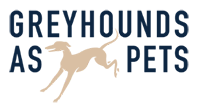While many greyhounds settle easily into their new home as if they were born for pet life, for others it can be an overwhelming and traumatic transition, at least initially.
The experiences a dog has during their first few months of life, along with their genetics, largely determine how they will behave in response to different situations and a lack of appropriate early socialisation can have lifelong implications. Most greyhound puppies grow up in a rural environment and likely haven’t encountered everyday urban and domestic things such as washing machines, traffic, different floor surfaces, stairs, glass doors, different breeds of dogs, other species of animals and a wide variety of people, including children.
As you can imagine, transitioning to pet life and all the sights, sounds, and smells that come along with it can be an information overload! Your greyhound is likely experiencing many things for the first time in their life and this can be frightening for them or cause them to experience anxiety.
Dogs communicate largely through their body language and through careful observation you can determine how your dog is feeling and respond appropriately to keep yourself and your hound safe.
Body language and behaviour to look out for:
When dogs are feeling threatened or under stress, they have four options:
Fidget/Fool around: this is a way for the dog to relieve stress when they aren’t sure what to do, a bit like making a joke in an uncomfortable situation or chewing your nails when nervous.
Over the top squirming and wriggling, writhing on the ground rolling over, frantic playing, scratching, sniffing the ground, licking, looking away, being clingy with their owner. Sometimes dogs will be conflicted and might try to get you to play by bowing and barking, but then roll over on their back when you approach.
Freeze: greyhounds are known for displaying the freeze response and is a bit like playing possum, thinking “maybe if I stay still the scary thing will go away”
Frozen or stiff posture, pupils dilated, increased respiratory rate, trembling, tense closed mouth, ears back, tail tucked, body hunched, might have all feet stuck to the floor and leaning backwards
Flight: this is attempting to get further away from the threat to hide or avoid it
Ears back, tail tucked, actively trying to escape – slinking away or running. Mouth closed or panting with tight not loose tongue hanging out if mouth, brow furrowed, pupils dilated.
Fight: this is aggressively confronting the threat, typically as a last resort
- Offensive: Unable to disengage. Lunging forward, ears forward, tail up, hackles may be up, showing front of teeth, lip curled, direct stare. May also vocalise, barking, snarling, or excessive growling. Standing tall and square, body weight forward. May attempt to bite.
- Defensive: Body crouched, ears pinned, tail tucked, hackles may be up, showing all teeth including molars, whale eye focused on trigger. May air snap, growl or bark.
How to help your Greyhound:
- Take your time. Allow the dog to observe and choose to investigate new people or objects at their own pace, rather than you approaching them or luring them towards it with food.
- Reward relaxed body language and natural investigation with calm verbal praise. You can toss treats onto the floor for your dog to eat if they are uncomfortable approaching your hand or snatching food, though many dogs will not eat if they are fearful. If your dog is approaching and soliciting attention by leaning on you or nudging you, you can pat them calmly.
- Be mindful of your own body language and behaviour around your dog. Being too cautious around your dog may have a detrimental effect, whereas being light- hearted or calm, not making a big fuss can help.
- Touch can help to release oxytocin, a chemical that plays a role in social bonding. If your dog seeks out and is comforted by touch, then calm patting may help to increase relaxed behaviour. You cannot reinforce fear by comforting your dog, but it is possible to accidentally encourage certain fearful behaviours. For example, by petting a dog when they roll onto their back if uncomfortable, it can make it more likely that the dog will keep offering this fearful body posture.
- If your dog is displaying signs of stress, anxiety or fear, you are less threatening to your dog by ignoring them, crouching or sitting down, turning your body away, and avoiding direct eye contact.
- Crates can be a valuable tool to provide your dog with a safe space to retreat to where they can observe things without any pressure. However, some dogs may display confinement stress in enclosed spaces and their anxiety escalates, not all dogs benefit from spending time in the crate and may be better suited to spending time in a fenced area outdoors or a dog proofed room.
- Observe your dogs body language closely in new situations.
- Always supervise interactions between dogs and children.
- Your greyhound is familiar with wearing a plastic basket muzzle and it can be a good idea to muzzle them in new situations for safety. Keep your greyhound on lead and wearing a martingale collar or well fitted harness when off your property. This will also be a clear indicator to other people and their dogs to give you some space.
